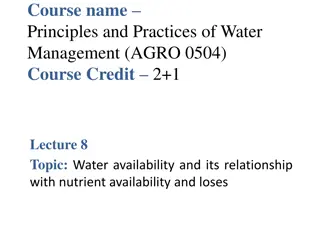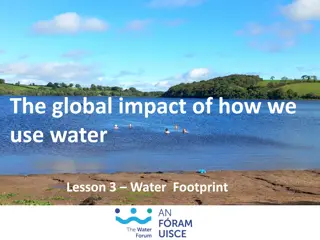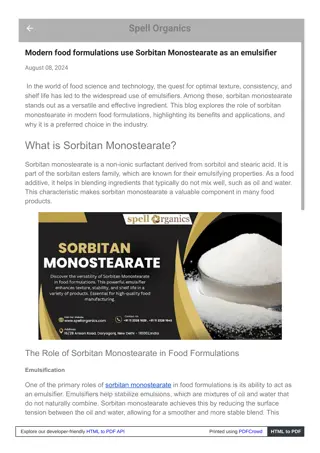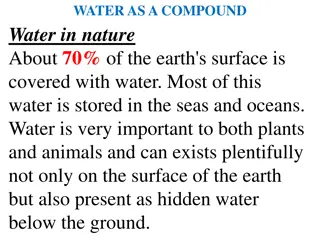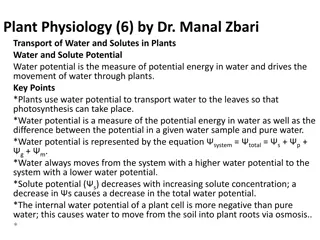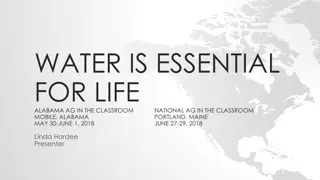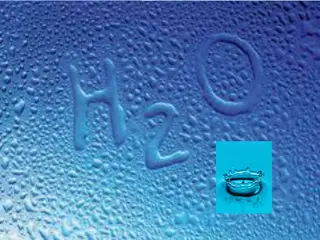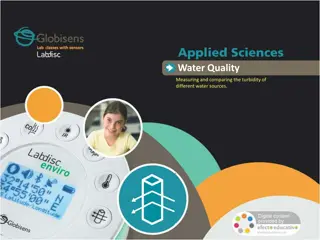The Fascinating World of Water: A Vital Element for Life
Water is essential for life on Earth, constituting about 70% of the planet's surface. With its unique chemical makeup (H2O) and properties, water exists in three states and undergoes various physical changes. Fun facts like water's unusual behavior when it freezes add to its allure. Understanding the water cycle, including evaporation, condensation, precipitation, and collection, sheds light on this life-sustaining resource.
Download Presentation

Please find below an Image/Link to download the presentation.
The content on the website is provided AS IS for your information and personal use only. It may not be sold, licensed, or shared on other websites without obtaining consent from the author.If you encounter any issues during the download, it is possible that the publisher has removed the file from their server.
You are allowed to download the files provided on this website for personal or commercial use, subject to the condition that they are used lawfully. All files are the property of their respective owners.
The content on the website is provided AS IS for your information and personal use only. It may not be sold, licensed, or shared on other websites without obtaining consent from the author.
E N D
Presentation Transcript
Water- its everywhere! Water is the key to our survival on Earth, it is our source of life Water is everywhere! It makes up about 70% percent of the Earth s surface Of that water, about 97% is ocean, and only 3% is fresh water File:Earth's water distribution.svg
Chemical make-up Water has the chemical formula H2O. A water molecule contains one oxygen and two hydrogen atoms connected by covalent bonds.
Above boiling Between freezing and boiling Below freezing SOLID- LIQUID- GAS THREE STATES OF WATER SOLID GAS LIQUID
Physical Changes of Water Condensation GAS LIQUID Evaporation LIQUID GAS Freezing LIQUID SOLID Melting SOLID LIQUID Sublimation SOLID GAS Frost Formation GAS SOLID
Fun Fact! Most liquids contract (get smaller) when they get colder. Water is different. Water contracts until it reaches 4 C then it expands until it is solid. So, solid water is less dense than liquid water! If water worked like other liquids, then there would be no such thing as an ice berg, the ice in your soft drink would sink to the bottom of the glass, and ponds would freeze from the bottom up!
The Water Cycle! Evaporation Condensation Precipitation Collection
Evaporation Evaporation is when the sun heats up water in rivers or lakes or the ocean and turns it into vapor or steam. The water vapor or steam leaves the river, lake or ocean and goes into the air.
Condensation Condensation: Water vapor in the air gets cold and changes back into liquid, forming clouds EXAMPLE: Water forms on the outside of a cold glass on a hot day. That water didn't just leak through the glass! It actually came from the air. Water vapor in the warm air turns back into liquid when it touches the cold glass.
Precipitation Precipitation occurs when so much water has condensed that the air cannot hold it anymore. The clouds get heavy and water falls back to the earth in the form of rain, hail, sleet or snow.
Collection When water falls back to earth as precipitation, it may fall back in the oceans, lakes or rivers or it may end up on land. When it ends up on land, it will either soak into the earth and become part of the ground water that plants and animals use to drink or it may run over the soil and collect in the oceans, lakes or rivers where the cycle starts all over again!
Adhesion and Cohesion Adhesion Cohesion
Adhesion and Cohesion Water is attracted to other water. This is called cohesion. Water can also be attracted to other materials. This is called adhesion The oxygen end of water has a negative charge (-) and the hydrogen end has a positive charge (+). The hydrogens of one water molecule are attracted to the oxygen from other water molecules. This attractive force is what gives water its cohesive and adhesive properties.
Surface Tension Surface tension is the name we give to the cohesion of water molecules at the surface of a body of water EXAMPLE: When you place a drop of water onto a piece of wax paper, molecule in the water drop is attracted to the other water molecules in the drop. (there is no adhesion between the drop and the wax paper) This causes the water to pull itself into a shape with the smallest amount of surface area, a bead (sphere). All the water molecules on the surface of the bead are creating surface tension EXAMPLE: When you float a pin or a paperclip on the top if a glass of water, the water is able to hold up the metal even though the paper clip is heavier than water. Surface tension is not the force that keeps boats floating
Capillary Action Surface tension is related to the cohesive properties of water. Capillary action however, is related to the adhesive properties of water. EXAMPLE: You can see capillary action 'in action' by placing a straw into a glass of water. The water 'climbs' up the straw. One water molecule moves closer to a the straw molecules the other water molecules (which are cohesively attracted to that water molecule) also move up into the straw. Capillary action is limited by gravity and the size of the straw. The thinner the straw or tube the higher up capillary action will pull the water . Plants take advantage of capillary action to pull water from the into themselves. From the roots water is drawn through the plant by another force, transpiration.




